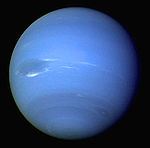- Thalassa (moon)
-
Thalassa  Naiad or Thalassa as seen by Voyager 2 (smearing has caused excessive elongation)Discovery
Naiad or Thalassa as seen by Voyager 2 (smearing has caused excessive elongation)DiscoveryDiscovered by Richard J. Terrile[1] and Voyager Imaging Team Discovery date September 1989 Epoch 18 August 1989 Semi-major axis 50 075 ± 1 km Eccentricity 0.0002 ± 0.0002 Orbital period 0.31148444 ± 0.00000006 d Inclination - 0.21 ± 0.02° (to Neptune equator)
- 0.21° (to local Laplace plane)
Satellite of Neptune Physical characteristicsDimensions 108×100×52 km[3][4] Mean radius 41 ± 3 km[5] Volume ~2.9×105km³ Mass ~3.5×1017 kg
(based on assumed density)Mean density ~1.2 g/cm³ (estimate)[5] Rotation period synchronous Axial tilt zero Albedo 0.09[3][5] Temperature ~51 K mean (estimate) Apparent magnitude 23.3[5] Thalassa (
 /θəˈlæsə/ thə-lass-ə; Greek: Θάλασσα), also known as Neptune IV, is the second innermost satellite of Neptune. Thalassa was named after sea goddesss Thalassa, a daughter of Aether and Hemera from Greek mythology. "Thalassa" is also the Greek word for "sea".
/θəˈlæsə/ thə-lass-ə; Greek: Θάλασσα), also known as Neptune IV, is the second innermost satellite of Neptune. Thalassa was named after sea goddesss Thalassa, a daughter of Aether and Hemera from Greek mythology. "Thalassa" is also the Greek word for "sea".Thalassa was discovered sometime before mid-September 1989 from the images taken by the Voyager 2 probe. It was given the temporary designation S/1989 N 5.[6] The discovery was announced (IAUC 4867) on September 29, 1989, but the text only talks of "25 frames taken over 11 days", giving a discovery date of sometime before September 18. The name was given on 16 September 1991.[7]
Thalassa is irregularly shaped and shows no sign of any geological modification. It is likely that it is a rubble pile re-accreted from fragments of Neptune's original satellites, which were smashed up by perturbations from Triton soon after that moon's capture into a very eccentric initial orbit.[8] Unusually for irregular bodies, it appears to be roughly disk-shaped.
Since the Thalassian orbit is below Neptune's synchronous orbit radius, it is slowly spiralling inward due to tidal deceleration and may eventually impact Neptune's atmosphere, or break up into a planetary ring upon passing its Roche limit due to tidal stretching. Relatively soon after, the spreading debris may impinge upon Despina's orbit.
References
- ^ Planet Neptune Data http://www.princeton.edu/~willman/planetary_systems/Sol/Neptune/
- ^ Jacobson, R. A.; Owen, W. M., Jr. (2004). "The orbits of the inner Neptunian satellites from Voyager, Earthbased, and Hubble Space Telescope observations". Astronomical Journal 128 (3): 1412–1417. Bibcode 2004AJ....128.1412J. doi:10.1086/423037.
- ^ a b Karkoschka, Erich (2003). "Sizes, shapes, and albedos of the inner satellites of Neptune". Icarus 162 (2): 400–407. Bibcode 2003Icar..162..400K. doi:10.1016/S0019-1035(03)00002-2.
- ^ Williams, Dr. David R. (2008-01-22). "Neptunian Satellite Fact Sheet". NASA (National Space Science Data Center). http://nssdc.gsfc.nasa.gov/planetary/factsheet/neptuniansatfact.html. Retrieved 2008-12-13.
- ^ a b c d "Planetary Satellite Physical Parameters". JPL (Solar System Dynamics). 2010-10-18. http://ssd.jpl.nasa.gov/?sat_phys_par. Retrieved 2011-10-11.
- ^ Green, Daniel W. E. (September 29, 1989). "Neptune". IAU Circular 4867. http://www.cbat.eps.harvard.edu/iauc/04800/04867.html. Retrieved 2011-10-26.
- ^ Marsden, Brian G. (September 16, 1991). "Satellites of Saturn and Neptune". IAU Circular 5347. http://www.cbat.eps.harvard.edu/iauc/05300/05347.html. Retrieved 2011-10-26.
- ^ Banfield, Don; Murray, Norm (October 1992). "A dynamical history of the inner Neptunian satellites". Icarus 99 (2): 390–401. Bibcode 1992Icar...99..390B. doi:10.1016/0019-1035(92)90155-Z.
External links
- Thalassa Profile by NASA's Solar System Exploration
- Neptune's Known Satellites (by Scott S. Sheppard)
Moons of Neptune Generally listed in increasing distance from NeptuneRegular (inner) Triton Irregular See also Neptune Discovery 
Characteristics - Rings
- Great Dark Spot
- Small Dark Spot
- The Scooter
- Kuiper belt
Moons Exploration Trojans Miscellaneous Categories:
Wikimedia Foundation. 2010.


